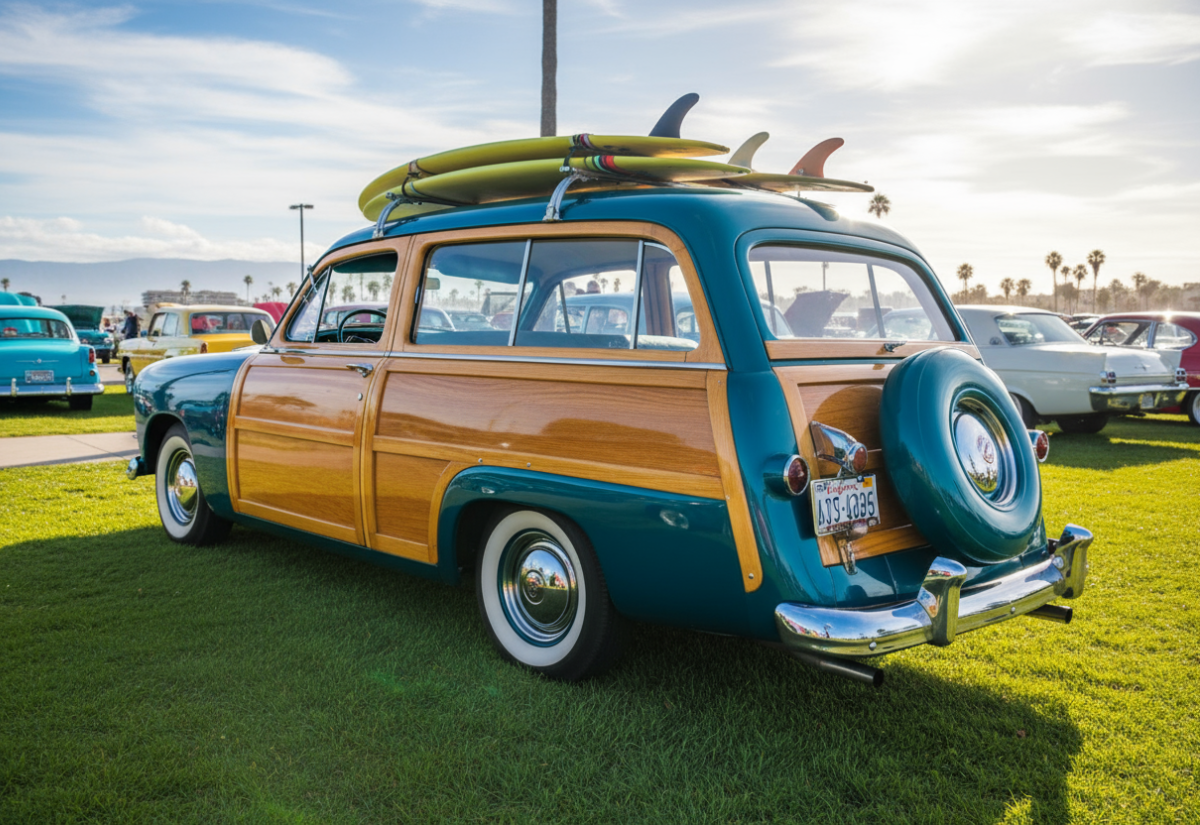Introduction
The woody car is more than just a mode of transportation — it’s a rolling piece of history that reflects craftsmanship, culture, and a unique era of automotive design. Recognizable by its distinctive wooden panels, the woody became a symbol of style and freedom in the mid-20th century, especially along America’s coastlines and in surf culture.
While production of true wood-bodied cars faded decades ago, their legacy continues to attract collectors, restorers, and enthusiasts who appreciate their rare combination of artistry and engineering. Today, the woody car stands as a nostalgic reminder of how design and lifestyle once came together on the open road.
The Origins of the Woody Car
The story of the woody car begins in the early 1910s and 1920s, when automobiles were still a new invention and manufacturers were experimenting with different materials. At the time, steel production was expensive, and many carmakers turned to wood as a practical solution. Wood was widely available, easier to shape, and familiar to craftsmen who had long used it in building carriages and wagons.
During these years, the first station wagons and utility vehicles featured wooden frames and panels. These early designs weren’t created for style — they were built for function. Wood made it possible to expand vehicle bodies to carry passengers, luggage, and even farm goods. Because of this, woody cars quickly became popular among hotels, resorts, and businesses that needed practical transport.
As car design evolved, wood framing became more than just a functional choice; it became part of the car’s identity. The combination of polished metal and varnished hardwood gave these vehicles a warm, handcrafted look that stood out on the road. By the late 1920s, the woody was no longer just a utility vehicle — it had become a symbol of craftsmanship and a new chapter in automotive history.
Design and Craftsmanship
One of the most recognizable features of the woody car is its wooden exterior. Unlike modern vehicles that rely entirely on steel or aluminum panels, these cars displayed polished hardwood as part of their body design. The wooden side panels, tailgates, and framing gave each model a warm, handcrafted look that metal alone couldn’t achieve. This blend of natural wood and shiny metal became a signature style that set the woody apart from other cars of its time.
The Distinctive Wooden Panels and Body Styles
Woody cars came in several styles, from station wagons with full wooden bodies to sedans and convertibles that only featured wood trim. The wide planks, decorative framing, and glossy finishes made each car stand out on the road. Because the woodwork was done by hand, no two models looked exactly the same, giving them a unique and custom-built feel.
Materials and Techniques Used in Classic Woody Construction
Manufacturers typically used hardwoods like oak, ash, or mahogany for framing and decorative panels. These woods were durable, yet flexible enough to be shaped into curved body lines. Skilled craftsmen, many with backgrounds in furniture-making or carriage-building, were employed to assemble and finish the wooden parts. The panels were sanded, stained, and varnished to bring out a deep shine, while joints and framing were carefully reinforced for strength.
Popularity and Cultural Impact
As the decades passed, the woody car moved from being a practical vehicle to a cultural icon. By the 1940s and 1950s, these cars were no longer just tools for transporting people and luggage — they had become symbols of style, leisure, and a distinctly American way of life.
Woody Cars in Movies, Music, and Surf Culture
Hollywood played a major role in shaping the woody’s image. Woody wagons often appeared in films as family vehicles or as the ride of choice for adventurous characters. In the 1960s, surf culture fully embraced the woody car, making it almost inseparable from the California lifestyle. Surfers favored these cars because of their roomy back ends, perfect for carrying long surfboards to the beach. Songs like “Surf City” by Jan and Dean even referenced the woody, cementing its place in music history.
Why They Became a Symbol of American Lifestyle
The woody car represented more than transportation — it symbolized freedom, the open road, and outdoor adventure. Families associated it with vacations and road trips, while young people saw it as a stylish way to express individuality. Its handcrafted look contrasted with the uniform steel cars that dominated the highways, giving it a sense of uniqueness and authenticity.
Types and Models of Woody Cars
Not all woody cars looked the same. Over time, manufacturers experimented with different body styles and designs, creating a variety of models that appealed to families, businesses, and eventually collectors. From practical station wagons to rare luxury editions, the woody became a versatile category of vehicles.
Station Wagons and Family Models
The most common type of woody car was the station wagon. These vehicles were designed with large wooden side panels and spacious interiors, making them perfect for families, hotels, and resorts that needed roomy transportation. Models like the Ford Country Squire and Chrysler Town & Country became household names, known for their comfort and practicality. Families loved them for road trips, while businesses used them as shuttle cars — solidifying the woody wagon’s place in everyday American life.
Rare and Collectible Editions
Beyond the popular wagons, several automakers produced limited or luxury versions of the woody. Some convertibles, sedans, and even coupes featured wooden trim, blending elegance with craftsmanship. These rarer editions often showcased premium woods, more detailed paneling, and limited production runs — factors that make them highly collectible today. Cars like the Buick Super Estate Wagon or the Packard Eight Woody Convertible are now prized by enthusiasts and can fetch high prices at auctions.
Collecting and Restoring Woody Cars
For car enthusiasts, the woody car represents one of the most rewarding — and sometimes most challenging — vehicles to own. Their rarity, craftsmanship, and strong ties to American culture have made them highly desirable among collectors. But owning one also requires patience, dedication, and respect for authenticity.
What Makes a Woody Car Valuable
The value of a woody car often depends on several factors: originality, condition, rarity, and historical significance. Models produced in limited numbers, or those with unique design features, tend to fetch the highest prices. Collectors also pay close attention to how much of the original wood and hardware has been preserved. A woody with intact factory woodwork and period-correct details will always be worth more than one that has been heavily modified. Provenance — knowing the history of the car and its previous owners — can also add to its collectible value.
Common Restoration Challenges
Restoring a woody car is unlike restoring a steel-bodied vehicle. Wood, even when properly treated, is vulnerable to rot, warping, and insect damage over time. Finding the right type of wood to match the original panels can be difficult, especially for rare models. Skilled craftsmanship is essential, since replacement pieces often need to be hand-shaped to fit the car’s body. Costs can also add up quickly, as restorers may need to hire both automotive mechanics and woodworking specialists to complete the project.
Tips for Preserving Authenticity
Collectors who want to maintain authenticity often take extra care in choosing materials and restoration methods. Using hardwoods like ash or maple — similar to the originals — helps preserve the car’s historical accuracy. It’s also important to keep original hardware, trim pieces, and factory design details whenever possible. Regular maintenance, such as sealing and varnishing the wood, protects the car from moisture and sunlight, extending its life for future generations.
The Woody Car in Today’s World
Even though true woody cars stopped rolling off production lines decades ago, their legacy continues to thrive. What was once a practical design born out of necessity has now become a celebrated piece of automotive history, cherished by collectors, hobbyists, and enthusiasts around the world.
Modern Appreciation and Car Shows
Classic car shows regularly feature woody cars as star attractions. Enthusiasts gather to admire the craftsmanship, compare restorations, and share stories about the vehicles’ history. In coastal communities, particularly in California, woody gatherings and “cruise-ins” remain popular events, often linked with surf culture nostalgia. These shows not only highlight the beauty of original woody cars but also keep their cultural importance alive for new generations.
Replica Builds and Retro-Inspired Vehicles
Because original wood-bodied cars are rare and expensive, some enthusiasts turn to replicas or retro-inspired builds. Modern replicas often use steel or fiberglass bodies with faux-wood paneling, capturing the look of a woody without the challenges of maintaining real wood. Automakers have also occasionally revived the style with nods to the past — for example, some station wagons and SUVs of the late 20th century offered “woodgrain” trim as a design option.
Conclusion
The woody car remains one of the most distinctive chapters in automotive history. From its practical beginnings in the early 20th century to its rise as a cultural symbol in surf music and Hollywood, the woody represents more than just a vehicle — it reflects craftsmanship, lifestyle, and nostalgia.
Though production of real wood-bodied cars ended long ago, their influence is still felt today at car shows, in collector circles, and through modern replicas that honor their timeless style. For enthusiasts, owning or even admiring a woody is about celebrating an era when design and personality were built into every detail.
FAQ About Woody Cars
Q1: What years were woody cars most popular?
Woody cars were most popular from the 1930s through the 1950s. During this time, manufacturers like Ford, Chrysler, and Buick produced station wagons and specialty models that highlighted wood craftsmanship. By the late 1950s, steel and other materials replaced real wood, making true wood-bodied cars less common.
Q2: Why did car makers stop using real wood in cars?
Carmakers moved away from real wood because it was expensive, labor-intensive, and required constant upkeep. Steel was easier to mass-produce, offered better durability, and lowered costs. Faux-wood paneling later replaced real wood to keep the style alive without the same challenges.
Q3: Are woody cars expensive to restore?
Yes, restoring a woody car can be costly. Original wood is difficult to find, and repairs require skilled craftsmanship in both woodworking and automotive mechanics. Depending on condition and rarity, restorations can range from moderate expenses to significant investments.
Q4: Can you still buy a new woody-style car today?
While manufacturers no longer build true wood-bodied cars, some modern vehicles feature faux-wood trim or retro-inspired styling. There are also custom builders who create replicas using modern materials, allowing enthusiasts to enjoy the classic woody look with fewer maintenance challenges.

